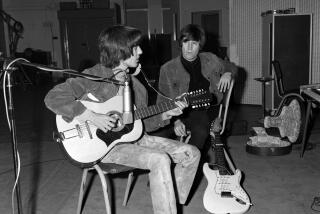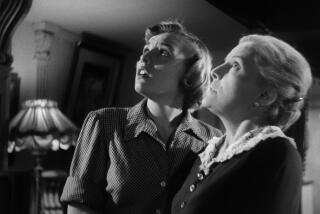What âThe King and Iâ and âHelp!â Have in Common
A movie doesnât have to be old to be on the verge of being lost forever.
Case in point: The 1964 and 1965 Beatles classics âA Hard Dayâs Nightâ and âHelp!â Most baby boomers will be hard pressed to believe the original negatives of the Fab Fourâs fabulous movie musicals were tattered, torn, dirty and virtually kaput.
But they were, and it took almost four years to restore the Richard Lester-directed romps to their original luster. And now the spruced-up versions will be unveiled during American Movie Classicsâ fourth annual Film Preservation Festival, taking place tonight through Friday on the cable channel.
âThe Beatles films are films that most people think, âGod, thatâs current,â â says Caroline Frick, AMCâs manager of acquisitions and archival programming. âThe fact of the matter is that these films were in terrible condition. I think a lot of people would be pretty upset if Paul McCartney is fading.â
This year, the AMC festival, designed to raise awareness and funds to benefit film preservation, is celebrating the musical, a genre that has become nearly extinct save for occasional animated and rock and pop films.
Besides premiering the restored Beatles flicks, the festival includes such delights as early sound musicals, big-budget studio musicals, jazz flicks and, for the younger audiences, rock ânâ roll musicals.
And Rodgers & Hammerstein fans will be in seventh heaven on Thursday when AMC presents a full day of the composersâ landmark musicals, including the TV premieres of the Todd-AO versions of 1955âs âOklahoma!,â 1958âs âSouth Pacificâ and 1965âs âThe Sound of Music,â and the Cinemascope 55 prints of 1956âs âThe King and Iâ and 1956âs âCarousel.â These movies will be presented in letterbox format.
*
Perhaps the festivalâs most unusual offerings, preserved by the Library of Congress, are musical shorts from 1923-26, which pre-date the first feature sound film, âThe Jazz Singer.â A short starring the Jubilee Four gospel group, Frick says, âis just remarkable. It was actually a sound-on-film test. The music is beautiful and the sound has really carried well.â
Says Frick: âWe are not trying to take a serious, somber look at the traditional Hollywood musical genre. We are saying, âLook, music has been an integral part of film and helped Hollywood become what it was with the musical.â Itâs really music and film and how the two are meshed. Thatâs what we are celebrating.â
The festival also reunites AMC with director Martin Scorsese and his Film Foundation, a consortium of filmmakers and archives dedicated to preventing and reversing the loss of our movie heritage.
The first three festivals raised a total of more than $1 million. The donations have financed projects of the UCLA Film and Television Archive, the Museum of Modern Art, the Library of Congress, George Eastman House and the National Center for Film and Video Preservation at the American Film Institute.
âThe archives have all been dumbfounded,â Frick says of the response. âI think it says that people are interested in giving to this. We are producing some new mini-documentaries that will talk about some of the films that have been saved with donated funds.â
For example, a portion of the money raised went to the Museum of Modern Art to restore John Fordâs classic 1946 western âMy Darling Clementineâ and Edwin S. Porterâs landmark 1903 western âThe Great Train Robbery.â
âSome money has trickled down to some very small regional archives,â Frick says, âincluding a historical society in Oregon that has done work on really old newsreels.â
Unfortunately, more than half of the 21,000 shorts and full-length features made on the unstable and highly flammable nitrate stock before 1950 have been lost. Three-quarters of the films from the Silent Era have been destroyed. Among the films that have been lost is a 1926 D.W. Griffith silent, âThe Royale Girl,â and 1927âs âLondon After Midnight,â with Lon Chaney.
And every film made on Eastman Color stock between 1950 and 1975 also is in danger of fading away. Though the fading process can be slowed, it canât completely be halted.
Color loss was one of the problems with âThe King and Iâ before it was restored. âAll of the prints were nice and purple,â says Library of Congress archivist David Parker, who specializes in musicals.
Paul Rutan Jr., director of laboratory restoration services at 4-Media Company Film Laboratories, who restored the Beatles films, thinks the Eastman Color problem is a far bigger concern than disintegrating nitrate stock.
âWhen I saw the very first scratch print on âHelp!â to see the quality of the negative, I was discouraged,â Rutan says. âI saw a significant amount of blue-layer fading in that and I thought, âOh, my god. We have lost the color.â â
But that ended up not being the case. The original negative, which was found in a Los Angeles vault, was severely damaged. One section, the Bahamas sequence, had a seven-foot tear that had been put back together with, of all things, Scotch tape.
*
Rutan says the versions of âHard Dayâs Nightâ and âHelp!â currently out on video are made from old prints. âThey are quite faded. You can correct some of the fading on videotape, but not a lot of it. You can make it more neutral. So both videotape versions available have a lot of dirt, damage and tears. Theyâre pretty ugly-looking.â
Rutan says it took a bit of work to get âHelp!â back on track. âEverything I do is photo-chemical. I donât use computer enhancements at all. My goal is to bring back what was there for the screen, not video. I believe we were 100% successful.â
The negative of âHard Dayâs Nightâ was in slightly better shape. âItâs a little bit easier because it is black-and-white, so there was no fading because there are no color dyes.â
The restored negatives of âHard Dayâs Nightâ and âHelp!â are now safely in deep-freeze storage at the Academy of Motion Picture Arts & Sciences.
And what about the movie musical itself? Can the genre be restored? The Library of Congressâ Parker thinks so.
âMusicals are dead because of the foreign market and the dubbing problem, and they are expensive to make,â he says. âBut those are not insurmountable problems. People have always come up with a second act for the genres in the past. The western was dead for 10 years. The musical has to be a new mix that will speak to contemporary audiences by somebody who does something in a clever, different way.â
More to Read
Only good movies
Get the Indie Focus newsletter, Mark Olsen's weekly guide to the world of cinema.
You may occasionally receive promotional content from the Los Angeles Times.











